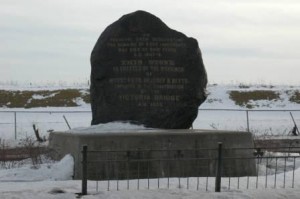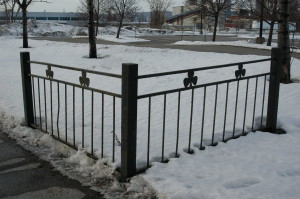It’s hard to find. Isolated on a traffic median on Bridge Street down by the St. Lawrence River a stone memorial sits dedicated to the Irish people in Montreal. As cars fly past, their occupants mostly unaware, the “Black Rock” with its bleak urban surroundings evokes feelings of neglect and of profound loss. It is estimated over six thousand Irish immigrants died from typhus in 1847-8 in Montreal, their bodies hastily buried in a rudimentary cemetery; six thousand souls lain to rest with no markers to commemorate their lives or their final resting places. Twelve years later, in 1859 while building the Victoria Bridge, Irish construction workers unknowingly unearthed the remains of residents from their beloved homeland. Wanting to ensure the graveyard would suffer no further desecration, they excavated a large black granite stone from the River and dedicated it to their memory.
The inscription reads:
“TO
PRESERVE FROM DESECRATION
THE REMAINS OF 6000 IMMIGRANTS
WHO DIED OF SHIP FEVER
A.D. 1847-8.
THIS STONE
IS ERECTED BY THE WORKERS
OF
MESSRS PETO, BRASSEY & BETTS,
EMPLOYED IN THE CONSTRUCTION
OF THE
VICTORIA BRIDGE
A.D. 1859”
It is the first memorial to the Irish people erected in Canada.
A plaque accompanies the stone, its message offered in Gaelic, French, and English:
“In 1847, six thousand Irish people, seeking refuge in a new land, died here of typhus and other ailments, and were buried in mass graves. The stone marks approximately the centre of the cemetery. Immediately to the east of here, twenty-two hospital sheds had been constructed. Many Grey Nuns, several priests, and also John Easton Mills, Mayor of the City of Montreal, who selflessly came to care for the sick, themselves contracted typhus and died. May they rest in peace.”
The last wistful line of the plaque resonates with its readers. Rest in peace? These desperate, poor Irish immigrants’ remains are lost in a “cemetery” marred by train tracks, roads, parking lots, overhead signage, and the sully of urban industrialization. Mothers, father, children, babies. Their only enduring legacy is a little strip of greenery cordoned off by a measly wrought-iron fence splattered with shamrocks, scarcely noticeable by passing motorists. Even what little recognition the stone offered was threatened in 1900 when the monument was removed to make room for development. It would take ten years before the Irish community would win their fight to have the Black Rock returned. Little consolation. The precious souls of six thousand people still remain buried beneath a concrete jungle.
There’s good news. Last year, a new movement to create a lasting tribute to the thousands lost to typhus in Montreal was founded. May they find a way to offer a fitting tribute to those lost not only to the Famine, but those who died helping care for the afflicted.
Perhaps then, they truly can rest in peace.



1 comment for “Black Rock Irish Memorial: Montréal, Québec”